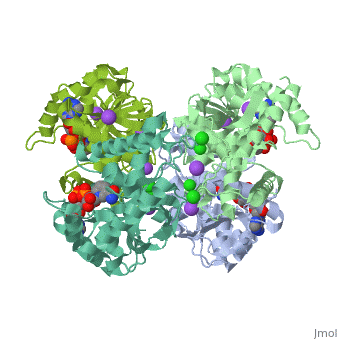2x0r
From Proteopedia
R207S, R292S Mutant of Malate Dehydrogenase from the Halophilic Archeon Haloarcula marismortui (HoloForm)
Structural highlights
FunctionMDH_HALMA Catalyzes the reversible oxidation of malate to oxaloacetate.[HAMAP-Rule:MF_00487] Evolutionary ConservationCheck, as determined by ConSurfDB. You may read the explanation of the method and the full data available from ConSurf. Publication Abstract from PubMedThe three-dimensional crystal structure of the (R207S, R292S) mutant of malate dehydrogenase from Haloarcula marismortui was solved at 1.95A resolution in order to determine the role of salt bridges and solvent ions in halophilic adaptation and quaternary structure stability. The mutations, located at the dimer-dimer interface, disrupt two inter-dimeric salt bridge clusters that are essential for wild-type tetramer stabilisation. Previous experiments in solution, performed on the double mutant, had shown a tetrameric structure in 4M NaCl, which dissociated into active dimers in 2M NaCl. In order to establish if the active dimeric form is a product of the mutation, or if it also exists in the wild-type protein, complementary studies were performed on the wild-type enzyme by analytical centrifugation and small angle neutron scattering experiments. They showed the existence of active dimers in NaF, KF, Na(2)SO(4), even in the absence of NADH, and in the presence of NADH at concentrations of NaCl below 0.3M. The crystal structure shows a tetramer that, in the absence of the salt bridge clusters, appears to be stabilized by a network of ordered water molecules and by Cl(-) binding at the dimer-dimer interface. The double mutant and wild-type dimer folds are essentially identical (the r.m.s. deviation between equivalent C(alpha) positions is 0.39A). Chloride ions are also observed at the monomer-monomer interfaces of the mutant, contributing to the stability of each dimer against low salt dissociation. Our results support the hypothesis that extensive binding of water and salt is an important feature of adaptation to a halophilic environment. The Oligomeric states of Haloarcula marismortui malate dehydrogenase are modulated by solvent components as shown by crystallographic and biochemical studies.,Irimia A, Ebel C, Madern D, Richard SB, Cosenza LW, Zaccai G, Vellieux FM J Mol Biol. 2003 Feb 21;326(3):859-73. PMID:12581646[1] From MEDLINE®/PubMed®, a database of the U.S. National Library of Medicine. See AlsoReferences
| ||||||||||||||||||||


